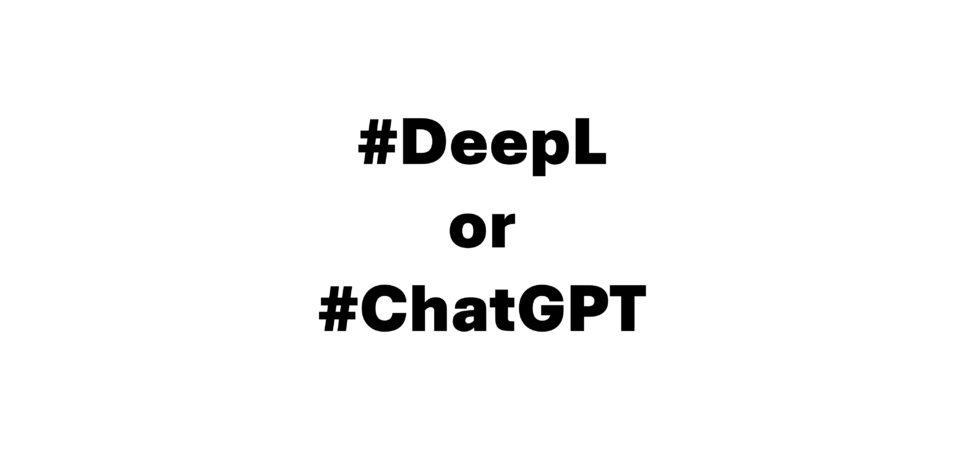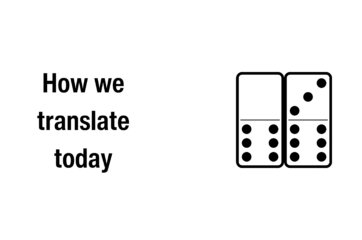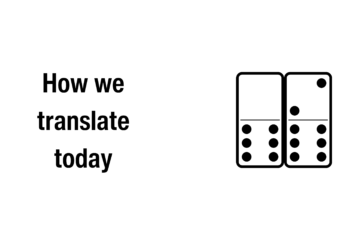DeepL or ChatGPT: which AI translation tool is right for you?

As large language models (LLMs) continue to reshape the landscape of AI translation tools and content creation, the lines between specialised systems and general-purpose AI are beginning to blur. While DeepL has long been a go-to solution for fast, high-quality translations across many languages, ChatGPT has recently entered the conversation as a flexible tool capable of much more than just basic translation. But how do they really compare? Which tool is optimal for your use case?
What are DeepL and ChatGPT?
DeepL is a dedicated neural machine translation (NMT) system, built specifically for high-quality translations across major language pairs. As of August 2025, DeepL translates into 40 languages and language variants, including most European and some Asian languages. Its architecture ensures fast processing, its output is of dependable quality, and its interface is built for ease of use. With features like glossary integration and file translation support, it’s particularly strong in technical and corporate contexts.
ChatGPT, by contrast, is more of a linguistic all-rounder. It’s a LLM designed for general-purpose language generation. Translation is just one of its capabilities, alongside summarisation, creative writing, and conversational interaction. While not built for translation specifically, it handles translation well when context, tone, and phrasing flexibility are important, especially when guided through prompts.
Additionally, ChatGPT is less limited in language coverage. ChatGPT can understand and generate text in dozens of languages more than DeepL, including many low-resource or regional languages such as Welsh, Afrikaans, Tagalog, and even Swiss German dialects. That said, breadth doesn’t always mean depth. While ChatGPT can translate or converse in many languages, the quality of its translations and conversations varies. With less-represented languages, fluency might drop, grammar can falter, or cultural idioms may be misinterpreted. Still, its ability to handle multilingual and code-switched input makes it extremely valuable in informal, cross-cultural, or exploratory contexts.
Real-world translation scenarios
To understand where each system shines, or falls short, let’s look at how these AI translation tools handle different real-world translation challenges.
Accuracy and fidelity
When it comes to accuracy and sentence-level fidelity, DeepL consistently delivers more stable translations. Optimised specifically for machine translation, DeepL prioritises direct alignment between source and target sentences. This focus allows it to maintain consistency across repeated terms and structures, particularly when supported by glossary features. That means that if a sentence appears in a document twice, DeepL usually returns the same translation.
In contrast, ChatGPT is built for open-ended text generation, not deterministic translation. Variability and creativity are introduced by design, and fluency and plausibility are prioritised over strict textual alignment. That is why Chat GPT can occasionally hallucinate content or rephrase in ways that drift from the original meaning and structure.
Stylistic and creative flexibility
For creative or conversational content, AI translation tools need to do more than match words – they must convey tone and intent.
It’s no secret that ChatGPT has the upper hand when it comes to style and tone adaptation. It allows users to interactively adjust the output, whether making a message more formal, more casual, or even more persuasive, making it an effective asset for contexts like marketing, client communication, or even storytelling.
DeepL, by contrast, tends to stick closely to the source text, offering grammatically correct but often literal translations with limited stylistic variation. This can lead to outputs that feel stiff or unnatural in informal or expressive content.
Handling of idioms, cultural references, and tone
Idioms, cultural references, and subtle tone shifts often pose a challenge for AI translation tools. This is where ChatGPT tends to outperform DeepL. DeepL frequently translates idiomatic expressions literally, which can result in confusing or awkward phrasing in the target language.
ChatGPT, on the other hand, is better at recognising figurative language and adapting it to culturally appropriate or idiomatic equivalents, especially when prompted with context or tone instructions. This makes it particularly useful for marketing copy, dialogue (e.g. in subtitle translation), or content where tone and natural flow matter as much as accuracy.
Document length and context dependence
Longer content can test the limits of AI translation tools, especially when consistency and nuance matter.
When translating longer texts, ChatGPT has a clear advantage thanks to its large context window. It allows ChatGPT to retain and reference more surrounding content during translation. This results in greater coherence across paragraphs, better handling of pronoun references, and more consistent tone and terminology over the course of a document.
DeepL processes texts in smaller chunks, which can lead to minor inconsistencies in wording or shifts in tone across sections.
Specialised terminology and brand glossaries
When it comes to using specialised terminology or adhering to brand-specific language, DeepL offers a clear advantage with its built-in glossary feature. It allows users to define how certain terms should be translated across a document or project. This promotes consistency in technical, legal, or branded content and can be especially helpful in product localisation and documentation with consistent terms.
ChatGPT, while highly flexible, does not currently offer integrated glossary control, and term consistency relies on careful prompting or manual guidance. While it can follow instructions like “always translate X as Y,” this method can be error-prone over longer texts.
For terminology-heavy content, DeepL’s glossary support makes it a more reliable AI translation tool.
Practical AI translation tool examples
Sentence alignment and fidelity
This example illustrates that DeepL adheres more closely to the structure of the original text, preserving the two-sentence format and mirroring the phrasing. This is an acceptable structure for technical documentation. ChatGPT takes more liberties with the structure, merging the sentences into a more fluid construction. This approach breaks the 1:1 sentence alignment but results in a smoother, more natural-sounding English version.
Original: Der neue Sensor erfasst selbst kleinste Bewegungen im Raum. Dabei passt er seine Empfindlichkeit automatisch an die Umgebungsbedingungen an.
DeepL: The new sensor detects even the slightest movements in the room. It automatically adjusts its sensitivity to the ambient conditions.
ChatGPT: The new sensor detects even the slightest movements in the room, automatically adjusting its sensitivity to the surrounding conditions.
Formal versus informal email
Both DeepL and ChatGPT handle formal emails well. Both produce clear, polite translations that maintain a professional tone. However, when the tone becomes less formal or conversational, DeepL can sound overly stiff or literal. In the same context, ChatGPT offers more flexibility in adapting to tone, intent, and phrasing. In this example, the DeepL translation is correct, but slightly rigid. ChatGPT’s version feels more natural and aligned with the casual tone of the original. ChatGPT’s ability to adjust style interactively makes it especially useful for communication that isn’t strictly formal.
Original: Just checking in to see if you had time to review the document.
DeepL (with the Formality setting set to “Informal”): Ich wollte nur mal nachfragen, ob du schon Zeit hattest, das Dokument durchzusehen.
ChatGPT: Wollte nur kurz nachfragen, ob du schon einen Blick auf das Dokument werfen konntest?
Marketing content
When translating marketing or creative content, ChatGPT typically outperforms DeepL by offering more natural and engaging translations. As in the previous example, DeepL provides a correct but often literal translation. ChatGPT is better at capturing the underlying intent and rephrasing it in a more creative manner. Additionally, ChatGPT allows users to specify localisation requirements directly in the prompt, such as adapting for European vs. Brazilian Portuguese, regional phrasing, or cultural tone. This makes ChatGPT a valuable tool for adapting content to different markets and cultural contexts when using AI translation tools.
Let’s say a German company wants to adapt a tagline for an English-speaking market. DeepL’s version, while clear and correct, sounds generic and uninspired. ChatGPT’s variant is more natural and market-friendly, with attention to tone and rhythm.
Original: Mehr Energie für Ihren Tag.
DeepL: More energy for your day.
ChatGPT: Power up your day.
Idiomatic expressions
Idiomatic expressions often pose a challenge in translation, as their literal meaning rarely reflects the intended message. DeepL handles such expressions with varying degrees of success. When it comes to language combinations with good coverage, like English-German or French-English, most idioms get translated well. But there are still some that slip through the cracks during model training.
This example shows how DeepL and ChatGPT handle a common German idiom with very different results.
Original: Ich habe heute Tomaten auf den Augen.
DeepL: I have tomatoes on my eyes today. → a literal rendering that makes little sense in English.
ChatGPT: I completely missed that. → captures and conveys the intended meaning more effectively, albeit not very creatively.
Summary
When choosing between AI translation tools, consider your content type, tone needs, and target audience. Both DeepL and ChatGPT are very useful AI translation tools, but their performance depends on the translation context.
DeepL excels at translating formal texts and standardised business documents, offering high accuracy, especially between European and Asian languages, and strong support for technical terminology through its glossary feature.
ChatGPT, on the other hand, is better suited when you need to tailor translations for different purposes. It allows for real-time adjustments to style, tone, or terminology, making it especially useful when context and nuance matter.
To help you maximise the benefits of these AI translation tools, we’ve created an overview of text types and translation contexts and how well DeepL and ChatGPT deal with them.
AI translation tool performance based on translation context
| Context | DeepL | ChatGPT |
| Glossary enforcement | ✅ User-defined glossary support | ⚠️Can handle many technical terms, but is less consistent unless guided through prompting |
| Style guide integration | ✅ Style guide definition is newly available in the interface | ✅ Well-suited for specifying style guidelines |
| Legal or financial texts | ⚠️ Reliable, consistent formal tone, but it may struggle with high precision texts | ⚠️ Risk of stylistic overreach or slight inaccuracies |
| Technical documentation | ✅ Precise terminology, consistent structure | ✅ High domain-specific accuracy, but prompt-dependent |
| Formal business emails | ✅ Clear, polite, professional tone | ✅ Can adapt tone if prompted |
| Informal messages | ⚠️ Often too stiff or literal | ✅ Easily adjusts tone to match intent |
| Social media content | ⚠️ Over-formal, tone mismatch possible | ✅ Engaging, adaptable, handles emojis/slang |
| Marketing content | ⚠️ Literal, occasionally awkward phrasing | ✅ Adapts for style, rhythm, and persuasive tone |
| Creative writing / storytelling | ❌ Too literal, lacks flow | ✅ Strong with voice, emotion, and narrative style |
| Low-resource languages | ❌ Limited or unsupported | ⚠️ Broader coverage but variable quality |
| Multilingual mixed input | ⚠️ Can struggle with code-switching | ✅ Handles mixed-language input smoothly |
-
AI translation tools
ChatGPT
DeepL
translation services


